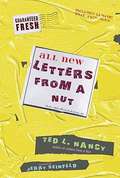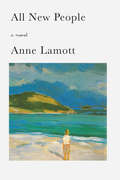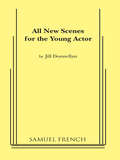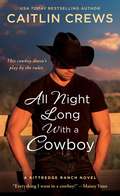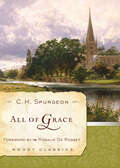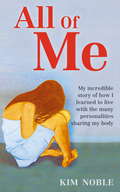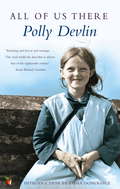- Table View
- List View
All New Dad Jokes: The perfect gift from the Instagram sensation @DadSaysJokes
by Dad Says JokesALL NEW CONTENT FROM THE ORIGINAL BESTSELLERAll New Dad Jokes is the second book from the most followed dad jokes page on Instagram, @DadSaysJokes. Now with a following of over 1 million, All New Dad Jokes provides brand new gags guaranteed to leave your friends and family laughing and groaning in equal measure.@DadSaysJokes is a community-run Instagram account with more than a million followers, inspired by the daily jokes of author Kit Chilvers' dad, Andrew. Every day, followers submit their jokes and the team picks their favourites - or Dad just drops in his own zinger! Kit, a young social networking mastermind started his career at the tender age of 14, when he created his original platform, Football.Newz, to serve audiences for the World cup 2014. He has recently added another nine platforms in different genres (of which @DadSaysJokes is one), with nine million followers and rising. This is his second book. Q: Where do naughty rainbows go?A: Prism.
All New Electronics Self Teaching Guide
by Earl Boysen Harry KybettFor almost 30 years, this book has been a classic text for electronics enthusiasts. Now completely updated for today?s technology with easy explanations and presented in a more user-friendly format, this third edition helps you learn the essentials you need to work with electronic circuits. All you need is a general understanding of electronics concepts such as Ohm?s law and current flow, and an acquaintance with first-year algebra. The question-and-answer format, illustrative experiments, and self-tests at the end of each chapter make it easy for you to learn at your own speed.
All New Homespun Handknit: 25 Small Projects to Knit with Handspun Yarn
by Amy Clarke MooreA follow-up to the original Homespun Handknit - a perennial bestseller for two decades - this collection revitalizes the craft of handspun yarn for a whole new generation of spinners and knitters. Packed with modern and traditional spinning know-how and 25 sophisticated, easy-to-learn projects, the guide helps crafters create unique gifts and wearable fashion while refining their skills and enhancing their understanding of this popular art form. With designs from some of the most influential knitters and spinners working today - including Kathryn Alexander, Jeanine Bakridges, and Abby Franquemont - this inspiring resource features hats, mittens, scarves, socks, bags, children's items, wraps, and home décor options to challenge fiber artists of all skill levels. Imparting essential and informative advice - on measuring yarns, reviewing woolen versus worsted, drive/tension differences, special techniques, and basic yarn dynamics - and complemented by basic knitting and spinning glossaries, this refreshing contemporary companion to a much-loved classic is an indispensable addition to every craft lover's bookshelf.
All New Letters from a Nut
by Jerry Seinfeld Ted L. NancyHe's back: the curse of customer service departments everywhere--Ted L. Nancy, letter writer extraordinaire whose imbecilic queries have a way of eliciting equally idiotic answers from some of the world's biggest companies and dignitaries. From the bestselling author of Letters from a Nut comes the latest collection of seemingly serious but crazed correspondence. All New Letters from a Nut includes more than 200 letters, from bizarre to outright loony requests and compliments written by Mr. Nancy to Icelandic malls, German theme parks, shoe museums, foreign presidents, commode companies, waffle cone businesses, and the Hotel Del Fino in Greece along with their equally sincere but hilarious responses. With his previous books, Ted L. Nancy distinguished himself as America's favorite postal humorist. This latest compilation highlights his comic status through letters to an upscale Amsterdam hotel requesting a room for his 300 hamsters and him to put on his play HAMSTERDAM; to Vons Supermarkets complaining that their Diet Black Cherry soda is sending him paranormal messages; to Armour Meats seeking a 59-foot piece of bologna and a note to the City of Glendale, California, asking for help in starting his new comedy club, THE JOKESTRAP; and many more.... Throughout Ted L. Nancy demonstrates his genius for convincing people his absurd queries are dead serious, demonstrated by the responses he receives. All New Letters From a Nut is unabashedly silly, unapologetically sophomoric, and 100% funny. With a foreword by Jerry Seinfeld
All New People: A Novel
by Anne LamottWith generosity, humor, and pathos, Anne Lamott takes on the barrage of dislocating changes that shook the Sixties. Leading us through the wake of these changes is Nanny Goodman, a girl living in Marin County, California. A half-adult child among often childish adults, Nanny grows up with two spectacularly odd parents: a writer father and a mother who is a constant source of material. As she moves into her adolescence, so, it seems, does America. While grappling with her own coming-of-age, Nanny witnesses an entire culture's descent into drugs, the mass exodus of fathers from her town, and rapid real-estate and technological development that foreshadow a drastically different future. In All New People, Anne Lamott works a special magic, transforming failure into forgiveness and illuminating the power of love to redeem us.
All New Scenes For Act
by Jill DonnellanThese 22 scenes are geared to actors over age 15 who are looking for something different, something a little disconcerting, and perhaps a little shocking! Perfect for acting classes, evenings of one acts, or private scene study.
All New Scenes For Young Actor
by Jill DonnellanThis collection of 14 scenes about contemporary topics appears to actors and actresses from 6 to 15. Issues range from baby-sitting and violin lessons to drugs and stolen money.
All Night Long
by Anne MatherAlly Sloan's flattered when a gorgeous stranger seeks her out. Single again after years in a loveless marriage, a heady night of desire is just what she needs to boost her confidence and remind her that life can be passionate. Off to the Bahamas the following day, Ally tells herself she's relieved not to be seeing Raul again -- she is older than he is, after all! But more than one surprise awaits her in the sultry heat of the Caribbean . . .
All Night Long
by Betsy JamesNick, the night zookeeper, has an important job: to care for all the animals while everyone else sleeps. Follow him along while he performs his nightly duties at the zoo.
All Night Long
by Janelle DenisonKristin wants one torrid night with Michael, to indulge her secret fantasies. When the night is over, can Michael convince her there could be more between them?
All Night Long
by Janelle DenisonKristin wants one torrid night with Michael, to indulge her secret fantasies. When the night is over, can Michael convince her there could be more between them?
All Night Long
by Jayne Ann KrentzShy, studious Irene Stenson and wild, privileged Pamela Webb had been the best of friends for one short high school summer. Their friendship ended the night Pamela dropped Irene off at home - and Irene walked in to discover her parents' bodies on the kitchen floor. It was ruled a murder-suicide, and Irene fled Dunsley, determined to wipe out every memory attached to her northern California hometown. But now she has been summoned back. Pamela's e-mail had been short and cryptic. More alarming, it included the code word they had used as teenagers, suggesting an urgency and secrecy that puzzled Irene. What could be important enough to make her former friend get in touch after all these years? She won't find out - at least not from Pamela, who lies dead in the luxurious home of her father, a U. S. senator, pill and liquor bottles beside her. The shock has barely subsided before the rumors begin to swirl. Irene had planned to get out of this place as quickly as possible. But her reporter's instinct - and her own hunger to know the truth - compel her to extend her stay at the local lodge. Even more compelling is the man who runs the place - a hazel-eyed ex-Marine who's as used to giving orders as Irene is to ignoring them. Luke Danner can see the terrified young girl hidden beneath Irene Stenson's black-clad, confident exterior - and he is intent on protecting her. But he is also driven by passions of his own, and together they will risk far more than local gossip to sort out what happened to Pamela Webb, and what really happened on that long-ago summer night.
All Night Long
by Jayne Ann KrentzAfter the violent deaths of her parents seventeen years ago, Irene Stenson left the tiny lakefront town of Dunsley, Oregon. Now she's back, and determined to discover the truth about what happened that night. Armed with a shocking new lead and her experience as an investigative reporter, Irene dives straight into the mystery and finds herself in deep trouble. Luckily, ex-Marine Luke Danner is on hand to pull her out, and his calm, quick-thinking response in the face of danger makes him the perfect ally. And as the intrigue deepens and the secrets turn deadly, Irene will need all the help she can find if she is to lay the past to rest.
All Night Long (Sweet Valley High #5)
by Francine PascalWelcome to Sweet Valley High--a world where good girls tell risky lies, bad girls make big mistakes, college boys are the biggest prize, and the party's still raging when the sun comes up. Jessica Wakefield has charmed many guys in her lifetime. But she's never met a challenge like Scott Daniels. He's gorgeous. He's experienced. He's in college. And when he invites her to a party at a secluded cabin on the lake, Jessica is determined to prove that she may be a junior in high school, but not when it comes to love. When Elizabeth discovers that Jessica never came home from the party, she panics. She can't get Jessica on her cell, and if their parents find out, both girls will be grounded until the end of time. There's only one way out--for Liz to pretend to be her twin. But she has no idea what she is getting herself into.
All Night Long with a Cowboy: A Kittredge Ranch Novel (Kittredge Ranch #2)
by Caitlin CrewsUSA Today bestseller Caitlin Crews returns with All Night Long with a Cowboy," another emotional romance in her stunning cowboy series Kittredge Ranch.If you play with fire…One of the most notorious cowboys in Cold River, Jensen Kittredge always has willing women with sweet smiles vying for a place in his bed. So when the prissy high school librarian sidles up to him in the most disreputable bar in town with a scowl on her face, he has no idea what to make of it. Much less the attraction he feels toward the bespectacled creature who wants something from him… but not that. Yet. Someone gets burned…Harriett Barnett doesn’t care for dens of iniquity— or the insolent cowboy she certainly shouldn’t find attractive. But one of her students needs her help, and if she needs to corral the infamous Jensen to save him, she will. Trouble is, the town’s favorite Kittredge brother is a lot more than she bargained for. Harriett's happy little life is orderly and neat, just how she likes it—until Jensen blows it all apart with his particular brand of addictive passion. Can a modern-day schoolmarm really tame the wildest cowboy in town? Or is Harriet headed for a terrible fall?
All Night Long: A Nannies Novel
by Melody MayerLYDIA KNOWS SHE blew it big-time with Billy, and winning him back is her numero uno priority before her endless LA summer finally does come to an end. Esme can't believe that a chica from Echo Park is going to spend senior year at über-wealthy Bel Air High, let alone that she'll have her two best friends with her. Except there's one tiny problem: the girl Esme was eager to help is slowly stealing Esme's life...Kiley doesn't know what she'd do without Tom to lean on. Not only is she trying to work through her panic attacks, but she's also been thrust into the national spotlight at the trial of Platinum. So with all that's going on, why can't Kiley get the guy she met at the all-night party out of her head?
All Night Lover
by Sylvia LettShe's ready for something new. . .Hoping to start over after a painful divorce, Cassie Mancini moves to Texas and is ready to cut loose. When she attends her sister's bridal shower, she can't resist dancing with the sexy male stripper. There's just one problem. The man isn't a stripper. He's the groom's best man, Dr. Adam Hart, and he's a notorious player. Humiliated, Cassie plans to keep her distance from Adam--even though she can't stop thinking about how good she felt in his arms. He's ready for her. . .Adam likes his life just the way it is. By not committing to anyone, he can have his choice of women. But when he meets Cassie, he's blown away by the sizzling chemistry they share. Determined to win her over, Adam sets out to capture Cassie's heart and prove to her that he's now a one-woman man. . . Praise for Sylvia Lett"With Perfect for You, Sylvia Lett offers a story of sizzling romance and dramatic suspense. A new writer to watch for." --Deirdre Savoy"Lett has written a fast-paced novel with suspense, intrigue and romance. This is a real page-turner." --Romantic Times on Take Me Down"Sylvia Lett is a magician at creating heroes to die for." --Evelyn Palfrey, Essence® bestselling author
All Night with the Boss
by Natalie AndersonRory Baxter is tall, dark and incredibly sexy. . . but he's also Lissa Coleman's new boss! Lissa doesn't do office affairs--but Rory tests her powers of resistance to the limit! Lissa's body responds to Rory's every move and goes into overdrive when he says he wants her. But once she's spent all night with the boss, the biggest problem is that one night will never be enough. . .
All Night with the Cowboy: A River Ranch Novel (A River Ranch Novel #2)
by Soraya LaneBillionaires, cowboys, and second chance romance collide in All Night with the Cowboy by Soraya Lane. BACK IN THE SADDLE. STRAIGHT TO THE HEART. . .At the Ford family ranch, getting thrown from a horse is a part of growing up. But one cowboy is still learning the ropes when it comes to falling in love.Tanner Ford has been riding bulls and busting broncos his entire life. So when he takes a hard spill—and sustains serious injuries—he refuses to believe his rodeo days are behind him. He’s determined to restore his body and revive his career. There’s just one problem: the finest physical therapist in town just happens to be the only woman he’s ever loved.Lauren Lewis knows she made a huge mistake when she walked away from Tanner. But she was young, ambitious, and focused on her medical career. Now, after all these years, Tanner’s back—and, in spite of his injuries, looking better than she allows herself to admit. She agrees to work on Tanner’s big bruised muscles until he’s back in bull-riding shape again. But how can Lauren resist the smoldering attraction between her and her old flame. . .and will she be able to live without him? “Lane warms hearts of readers across the globe.”—RT Book Reviews
All Note Long
by Annabeth AlbertGiving true love a spin . . .Michelin Moses is a country music star on the rise. With a hit single under his Texas-sized belt buckle and a sold-out concert tour underway, his childhood dreams of making it big are finally coming true. But there’s one thing missing—a promise to his dying mother that he’d find it—him—when the time was right. With a little luck, he won’t have to wait too long . . .Lucky Ramirez is a hunky boy toy who dances at The Broom Closet, one of West Hollywood’s hottest gay bars. He loves what he does, and he’s good at it—almost as good as he is at playing dumb when he spots Michelin Moses at the bar. What happens next is off the charts—and keeps Michelin coming back for more. He’s just not sure it’s the right move for his career. But if Lucky gets his way, Michelin will get Lucky—and no matter how the media spins it, neither of them will be faking it . . .
All Odd and Splendid: Poems
by Hilda RazThis collection of poems is an exploration of lives and selves transformed by choice and by chance. Formally and thematically diverse, these poems are testament to the will to redefine oneself in a world of constant, and often painful, change. Beginning intimately with poems of personal examination and moving gradually to the world of shared experience, Hilda Raz rethinks the structures of family and community while examining the impact of loss and growth. All Odd and Splendid takes its title from a quotation attributed to Diane Arbus, the American photographer known for her portraits. Raz's poems share Arbus's steadfast celebration of the strangeness in the ordinary, bringing us into contact with a beauty and pain that are inseparable when we see things as they truly are.
All Of Grace (Moody Classics)
by C .H. SpurgeonC. H. Spurgeon writes, &“Only God can justify the ungodly, but He can do it to perfection. He casts our sins behind His back; He blots them out. He says that though they be sought for, they shall not be found.&”In an age of limited travel and isolated nations, C.H. Spurgeon preached to over 10,000,000 people in person—sometimes up to 10 times per week. It is in this classic work that Spurgeon most clearly present the message of salvation—man&’s ultimate need and God&’s unique provision—both simply and sincerely, for honest seekers and zealous witnesses alike.
All Of Grace (Moody Classics)
by C .H. SpurgeonC. H. Spurgeon writes, &“Only God can justify the ungodly, but He can do it to perfection. He casts our sins behind His back; He blots them out. He says that though they be sought for, they shall not be found.&”In an age of limited travel and isolated nations, C.H. Spurgeon preached to over 10,000,000 people in person—sometimes up to 10 times per week. It is in this classic work that Spurgeon most clearly present the message of salvation—man&’s ultimate need and God&’s unique provision—both simply and sincerely, for honest seekers and zealous witnesses alike.
All Of Me: My incredible true story of how I learned to live with the many personalities sharing my body
by Jeff Hudson Kim NobleKim Noble is an accomplished artist whose work has been exhibited around the world. She is a mother with a 13-year-old daughter. She is a bubbly and vivacious woman. To meet her you wouldn't think anything was wrong. But when Kim was younger than five years old, her personality splintered and fractured. In 1995 she was finally diagnosed with Dissociative Identity Disorder (DID) which has been described as a creative way to cope with unbearable pain. Now her body plays host to more than 20 different personalities, or 'alters'. There are women and men, adults and children; there is a scared little boy who speaks only Latin, an elective mute, a gay man and an anorexic teenager. Some alters age with her body; others are stuck in time. ALL OF ME takes the reader through the extraordinary world of a woman for whom the very nature of reality is different. It will tell of her terrifying battles to understand her own mind; of her desperate struggle against all odds to win back the child she loved; and of her courage and commitment in trying to make sense of her life. It is by turns shocking, inspiring, sometimes funny, and deeply moving.
All Of Us There
by Polly DevlinPolly Devlin grew up in County Tyrone, on the shores of Lough Neagh, in the fifties -- but it might as well have been another time and place altogether. In this memoir she describes in witty, spontaneous and idiosyncratic prose her life as one of seven siblings in a Catholic family in Northern Ireland.'A brooding, evocative study of Irish childhood, of the strong bonds of love and jealousy that sisters especially feel, the guilt-ridden pressures of religion, the magical countryside, the eccentric villagers. A hauntingly lovely work ... beautifully written with poetic intensity which seems to encapsulate the Irish character with all its wit and bitterness and gift for words' HOMES AND GARDENS



